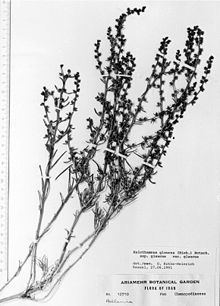Rank Species | Tribe Salsoleae | |
 | ||
Similar Halothamnus, Polycnemoideae, Halothamnus subaphyllus, Halothamnus hierochunticus, Halothamnus iranicus | ||
Halothamnus glaucus is a species of the plant genus Halothamnus, that belongs to the subfamily Salsoloideae of the family Amaranthaceae, (formerly Chenopodiaceae). It occurs in Western and Central Asia.
Contents
Morphology
Halothamnus glaucus is a sub-shrub up to 1 m high, with blueish-green pale-striped branches. The leaves are half-terete, fleshy, linear and up to 50 mm long and 0,7-2,0 mm wide. The bracts and bracteoles of the lower flowers are resembling the leaves, the bracts having basally wide membraneous margins. The flowers are 3,5-5,0 mm long with lanceolate-oval tepals, the stigmas are rounded at their tip. The winged fruit is 11–17 mm in diameter, their wings inserting in or something below the middle. The tube of the fruit is broadly cylindric, often dilated to its base, its bottom with circular-oval pits.
The species comprises three subspecies: subsp. glaucus, glabrous, and the stamen filaments 0,6-0,9 mm wide; subsp. hispidulus, densely hairy, and the stamen filaments only 0,5-0,7 mm wide; and subsp. tianschanicus with truncate stigmas.
Distribution
The distribution of Halothamnus glaucus extends from eastern Turkey over Georgia, Armenia, Azerbaijan, Turkmenistan, northern Iran, Kazakhstan, Uzbekistan, Kyrgyzstan to China (Dzungaria, possibly Kashgaria) and Mongolia, too. It grows in dry semideserts or mountain steppes on stony or clayey ground, partly on salty soils, up to 2000 m above sea-level.
Cultivation and uses
Halothamnus glaucus is an important fodder plant for camels, sheep and goats and is locally cultivated. In former centuries, potash was extracted from the ash of the plants. The roots and above ground parts of the plants are containing alkaloids.
Taxonomy
The species has been first described in 1798 by Friedrich August Marschall von Bieberstein as Salsola glauca (In: Tableau des provinces situées sur la côte occidentale de la Mer Caspienne, St. Pétersbourg, 1798, p. 112). In 1981, Victor Petrovič Botschantzev included it into the genus Halothamnus (In: Bot. Mater. Gerb. Bot. Inst. Komarova Akad. Nauk SSSR 18: p. 157). Within the genus, it belongs to section Halothamnus.
Halothamnus glaucus is classified into three subspecies:
Synonyms:
Synonyms:
Synonyms:
